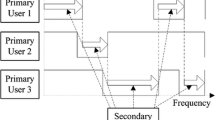Abstract
With time there is an increase in demand and usage of wireless services and applications. For efficiently utilizing the network bandwidth and memory space resources, a cognitive radio network is necessary. Spectrum sensing is the major functionality in CRN. It is the most crucial state included since the entire functionality completely relies on this stage. Schemes like energy detector, matched filter, pilot-based coherent detection, etc. exist for spectrum sensing their performance degrades as the presence of noise increases. Thus cyclostationary detector fulfills the necessary specifications of discovering the spectrum in the presence of low SNR. In this technique, the periodicity exhibited by the signal is utilized and enhanced by taking the similarity using the auto-correlation. The peaks of frequencies thus form a resultant of the correlated signal with Fourier transform with certain specificity to the signal to determine the presence of a primary user. On the contrary, the non-periodicity and random nature of noise don’t highlight it when taking correlation.




Similar content being viewed by others
References
Akyildiz IF, Lee WY, Vuran MC, Mohanty S (2006) NeXt generation/dynamic spectrum access/cognitive radio wireless networks: a survey. Comput Netw 50:2127–2159. https://doi.org/10.1016/j.comnet.2006.05.001
Arqub OA (2017) Adaptation of reproducing kernel algorithm for solving fuzzy Fredholm–Volterra integrodifferential equations. Neural Comput & Applic 28(7):1591–1610
Arqub OA, Abo-Hammour Z (2014) Numerical solution of systems of second-order boundary value problems using continuous genetic algorithm. Inf Sci 279:396–415
Arqub OA, Al-Smadi M (2020) Fuzzy conformable fractional differential equations: novel extended approach and new numerical solutions. Soft Comput 24(16):12501–12522
Camara TVRO, Lima ADL, Lima BMM, Fontes AIR, Martins ADM, Silveira LFQ (2019) Automatic modulation classification architectures based on Cyclostationary features in impulsive environments. IEEE Access 7:138512–138527. https://doi.org/10.1109/ACCESS.2019.2943300
Chaurasiya RB, Shrestha R (2019) Hardware-efficient and fast sensing-time maximum-minimum-eigenvalue-based Spectrum sensor for cognitive radio network. IEEE Trans Circ Syst I: Regular Papers 66(11):4448–4461. https://doi.org/10.1109/TCSI.2019.2921831
Force S (2002) Spectrum policy task force report Federal Communications Commission ET Docket 02, vol. 135. https://ci.nii.ac.jp/naid/10030187662/en/.
Gardner WA, Napolitano A, Paura L (2006) Cyclostationarity: half a century of research. Signal Process 86:639–697. https://doi.org/10.1016/j.sigpro.2005.06.016
Koroupi F, Talebi S, Salehinejad H (2012) Cognitive radio networks spectrum allocation: an ACS perspective. Sci Iran 19:767–773. https://doi.org/10.1016/j.scient.2011.04.029
Kriti, Kaul A (2017) A proposed algorithm to enhance security in CRN. Int J Sci Res Comput Sci Eng Inf Technol (IJSRCSEIT) 2:127–134. https://doi.org/10.32628/CSEIT174417
Kriti, Wasson V (2015) Cognitive radio networks and its related issues. Int J Res Electron Comput Eng 3(2):75–78
Kriti, Wasson V (2015) Cyclostationary feature detection in CRN. FOREX-IJCSR 3:149–153
Lundén J, Koivunen V, Huttunen A, Poor HV (2009) Collaborative cyclostationary spectrum sensing for cognitive radio systems. IEEE Trans Signal Process 57:4182–4195. https://doi.org/10.1109/TSP.2009.2025152
Mahapatra R, Krusheel M (2008) Cyclostationary detection for cognitive radio with multiple receivers. In: 2008 IEEE International Symposium on Wireless Communication Systems 493–497. https://doi.org/10.1109/ISWCS.2008.4726105.
Serbes A, Cukur H, Qaraqe K (2020) Probabilities of false alarm and detection for the first-order Cyclostationarity test: application to modulation classification. IEEE Commun Lett 24(1):57–61. https://doi.org/10.1109/LCOMM.2019.2947043
Srivastava V, Motani M (2005) Cross-layer design: a survey and the road ahead. IEEE Commun Mag 43:112–119. https://doi.org/10.1109/MCOM.2005.1561928
Tekbiyik K, Akbunar Ö, Ekti AR, Gorcin A, Karabulut Kurt G (2019) Multi–dimensional wireless signal identification based on support vector machines. IEEE Access 7:138890–138903. https://doi.org/10.1109/ACCESS.2019.2942368
Üstok RF (2010) Spectrum sensing techniques for cognitive radio systems with multiple antennas (Master's thesis, Izmir Institute of Technology). http://hdl.handle.net/11147/3518.
Xu Z, Petrunin I, Tsourdos A (2020) Identification of communication signals using learning approaches for cognitive radio applications. IEEE Access 8:128930–128941. https://doi.org/10.1109/ACCESS.2020.3009181
Yanbin S, Zhongji T, Xu L (2012) The application of the cognitive Radio in the Aviation Communication Spectrum Management. Phys Procedia 25:1720–1725. https://doi.org/10.1016/j.phpro.2012.03.301
Author information
Authors and Affiliations
Corresponding author
Ethics declarations
Conflict of interest
The Authors declares that there is no conflict of interest.
Additional information
Publisher’s note
Springer Nature remains neutral with regard to jurisdictional claims in published maps and institutional affiliations.
Rights and permissions
Springer Nature or its licensor holds exclusive rights to this article under a publishing agreement with the author(s) or other rightsholder(s); author self-archiving of the accepted manuscript version of this article is solely governed by the terms of such publishing agreement and applicable law.
About this article
Cite this article
Mahajan, K., Garg, U. An enhancement to the existing cyclostationary feature detection in CRN. Multimed Tools Appl 81, 37087–37099 (2022). https://doi.org/10.1007/s11042-022-13527-2
Received:
Revised:
Accepted:
Published:
Issue Date:
DOI: https://doi.org/10.1007/s11042-022-13527-2




